battery FORD ESCAPE 2021 Owners Manual
[x] Cancel search | Manufacturer: FORD, Model Year: 2021, Model line: ESCAPE, Model: FORD ESCAPE 2021Pages: 589, PDF Size: 9.2 MB
Page 2 of 589
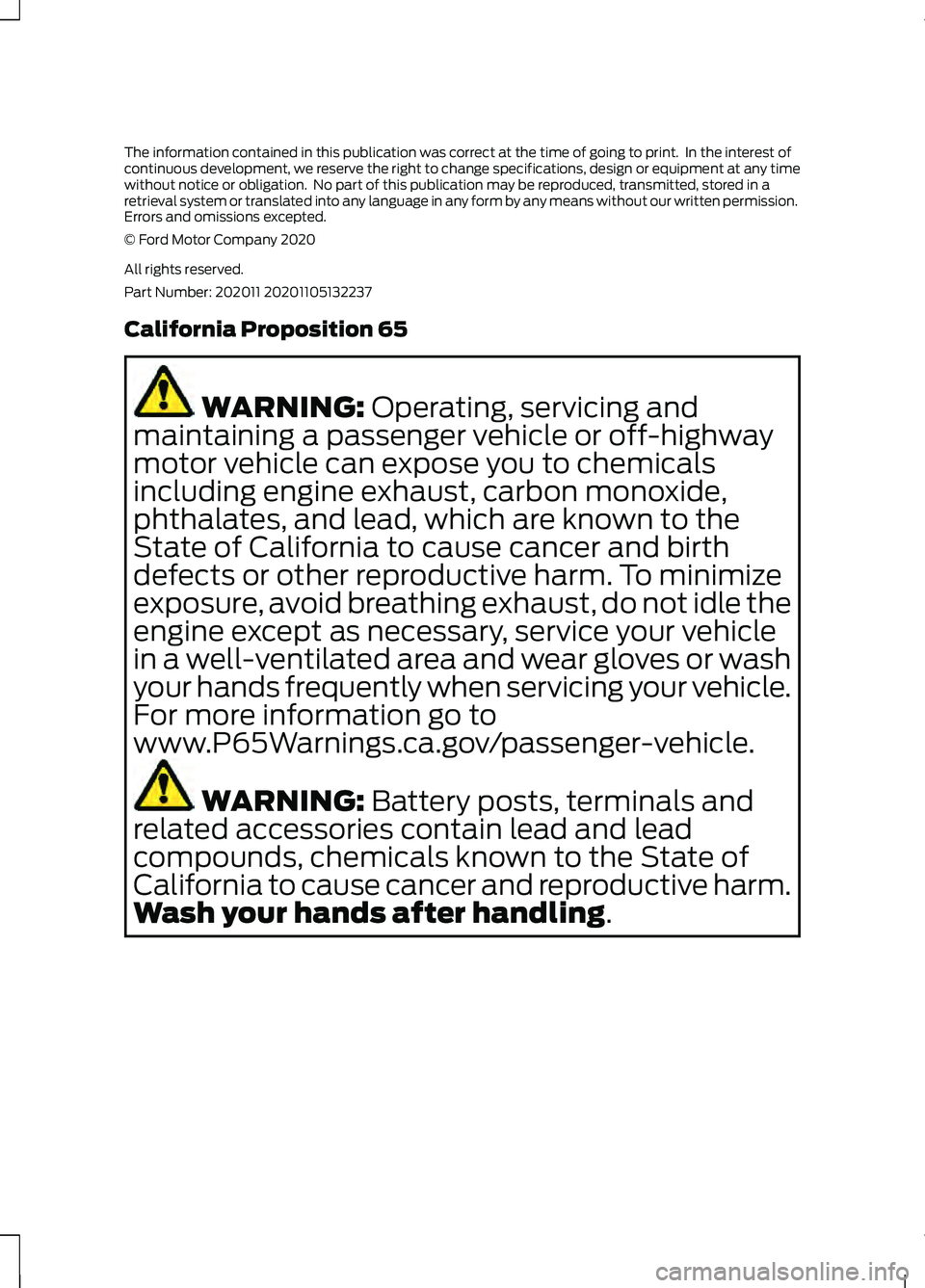
The information contained in this publication was correct at the time of going to print. In the interest of
continuous development, we reserve the right to change specifications, design or equipment at any time
without notice or obligation. No part of this publication may be reproduced, transmitted, stored in a
retrieval system or translated into any language in any form by any means without our written permission.
Errors and omissions excepted.
© Ford Motor Company 2020
All rights reserved.
Part Number: 202011 20201105132237
California Proposition 65
WARNING: Operating, servicing and
maintaining a passenger vehicle or off-highway
motor vehicle can expose you to chemicals
including engine exhaust, carbon monoxide,
phthalates, and lead, which are known to the
State of California to cause cancer and birth
defects or other reproductive harm. To minimize
exposure, avoid breathing exhaust, do not idle the
engine except as necessary, service your vehicle
in a well-ventilated area and wear gloves or wash
your hands frequently when servicing your vehicle.
For more information go to
www.P65Warnings.ca.gov/passenger-vehicle. WARNING:
Battery posts, terminals and
related accessories contain lead and lead
compounds, chemicals known to the State of
California to cause cancer and reproductive harm.
Wash your hands after handling
.
Page 5 of 589
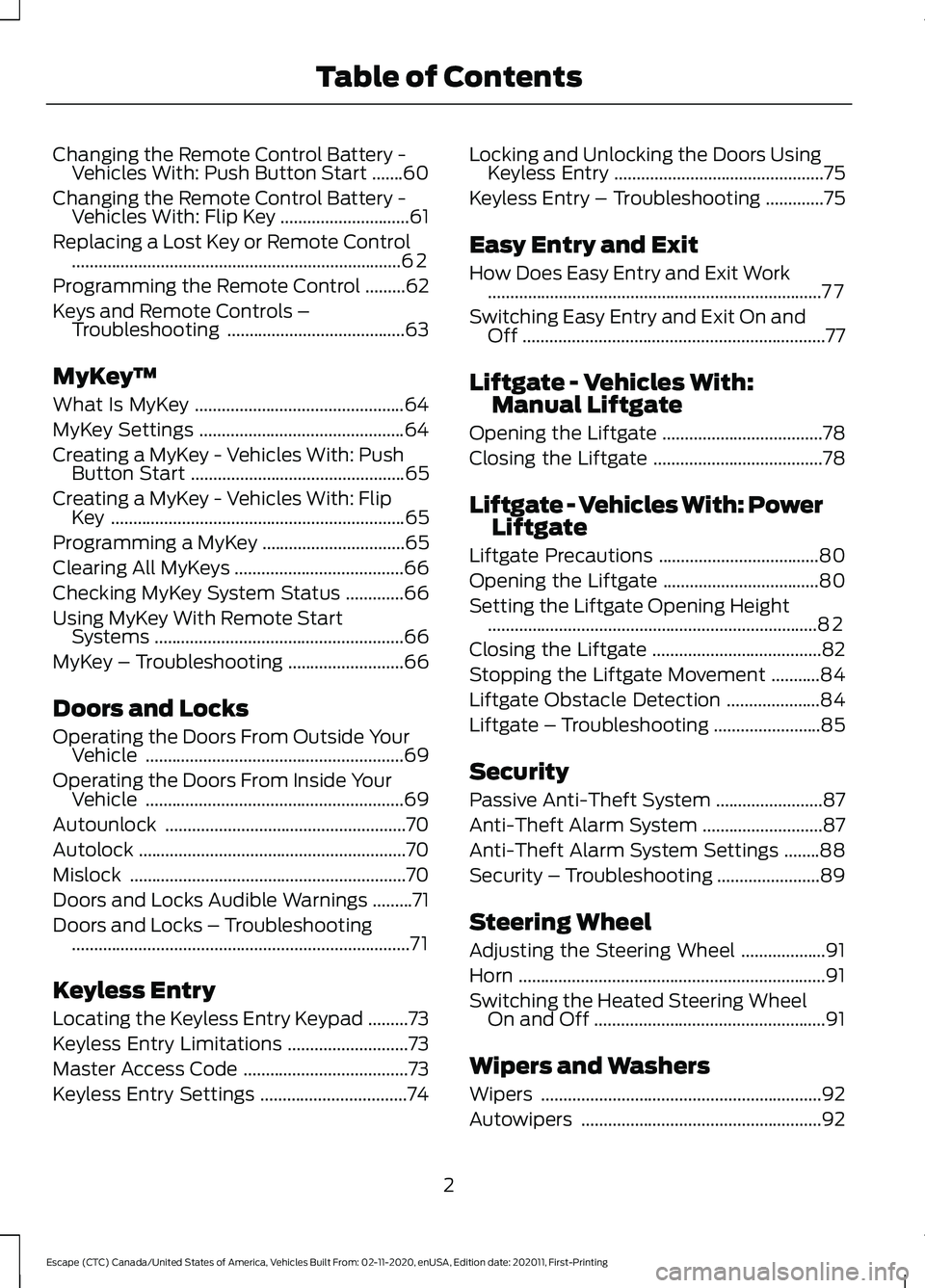
Changing the Remote Control Battery -
Vehicles With: Push Button Start .......60
Changing the Remote Control Battery - Vehicles With: Flip Key .............................
61
Replacing a Lost Key or Remote Control ........................................................................\
..
62
Programming the Remote Control .........
62
Keys and Remote Controls – Troubleshooting ........................................
63
MyKey ™
What Is MyKey ...............................................
64
MyKey Settings ..............................................
64
Creating a MyKey - Vehicles With: Push Button Start ................................................
65
Creating a MyKey - Vehicles With: Flip Key ..................................................................
65
Programming a MyKey ................................
65
Clearing All MyKeys ......................................
66
Checking MyKey System Status .............
66
Using MyKey With Remote Start Systems ........................................................
66
MyKey – Troubleshooting ..........................
66
Doors and Locks
Operating the Doors From Outside Your Vehicle ..........................................................
69
Operating the Doors From Inside Your Vehicle ..........................................................
69
Autounlock ......................................................
70
Autolock ............................................................
70
Mislock ..............................................................
70
Doors and Locks Audible Warnings .........
71
Doors and Locks – Troubleshooting ........................................................................\
....
71
Keyless Entry
Locating the Keyless Entry Keypad .........
73
Keyless Entry Limitations ...........................
73
Master Access Code .....................................
73
Keyless Entry Settings .................................
74Locking and Unlocking the Doors Using
Keyless Entry ...............................................
75
Keyless Entry – Troubleshooting .............
75
Easy Entry and Exit
How Does Easy Entry and Exit Work ........................................................................\
...
77
Switching Easy Entry and Exit On and Off ....................................................................
77
Liftgate - Vehicles With: Manual Liftgate
Opening the Liftgate ....................................
78
Closing the Liftgate ......................................
78
Liftgate - Vehicles With: Power Liftgate
Liftgate Precautions ....................................
80
Opening the Liftgate ...................................
80
Setting the Liftgate Opening Height ........................................................................\
..
82
Closing the Liftgate ......................................
82
Stopping the Liftgate Movement ...........
84
Liftgate Obstacle Detection .....................
84
Liftgate – Troubleshooting ........................
85
Security
Passive Anti-Theft System ........................
87
Anti-Theft Alarm System ...........................
87
Anti-Theft Alarm System Settings ........
88
Security – Troubleshooting .......................
89
Steering Wheel
Adjusting the Steering Wheel ...................
91
Horn .....................................................................
91
Switching the Heated Steering Wheel On and Off ....................................................
91
Wipers and Washers
Wipers ...............................................................
92
Autowipers ......................................................
92
2
Escape (CTC) Canada/United States of America, Vehicles Built From: 02-11-2020, enUSA, Edition date: 202011, First-Printing Table of Contents
Page 7 of 589
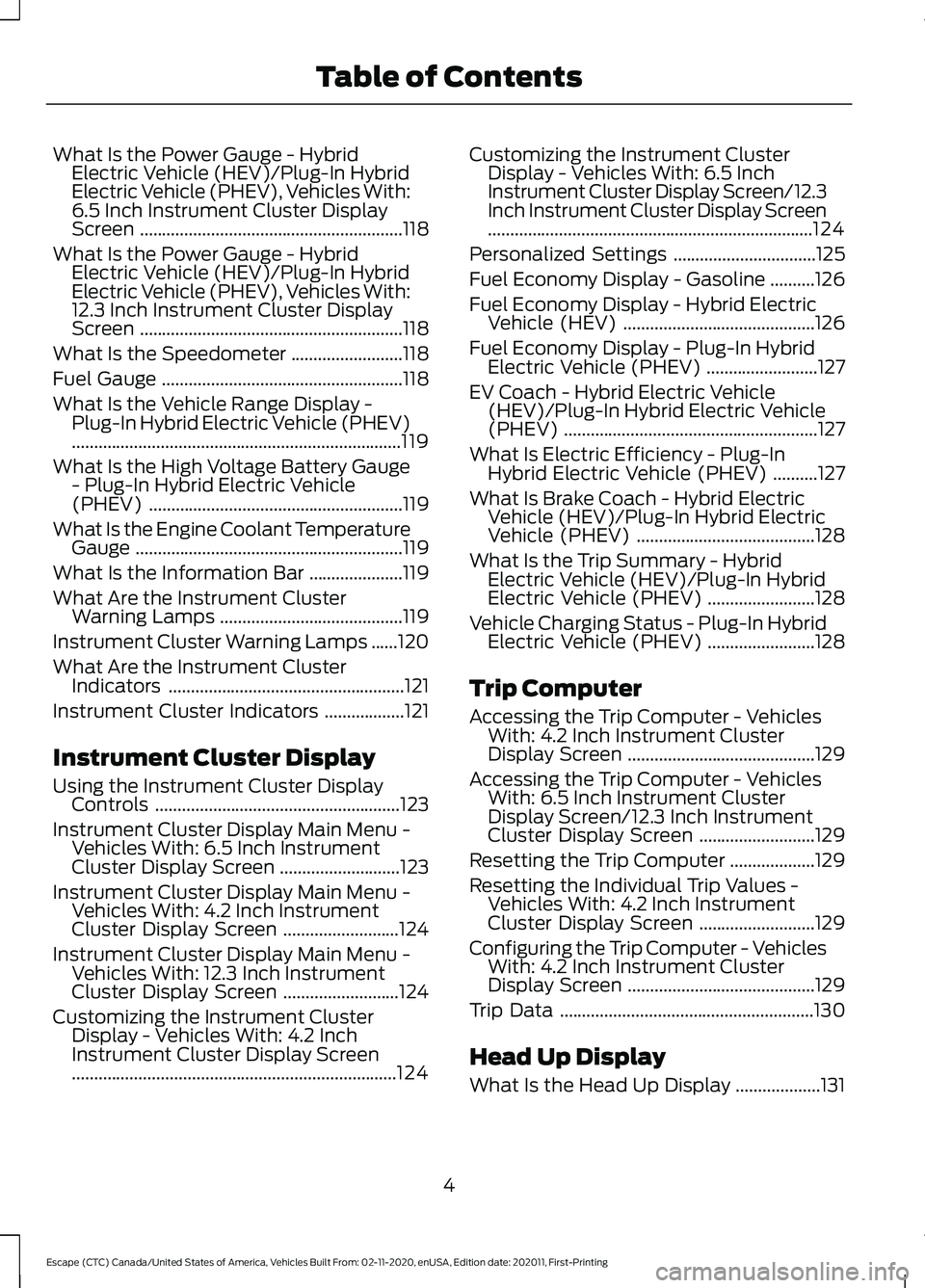
What Is the Power Gauge - Hybrid
Electric Vehicle (HEV)/Plug-In Hybrid
Electric Vehicle (PHEV), Vehicles With:
6.5 Inch Instrument Cluster Display
Screen ...........................................................118
What Is the Power Gauge - Hybrid Electric Vehicle (HEV)/Plug-In Hybrid
Electric Vehicle (PHEV), Vehicles With:
12.3 Inch Instrument Cluster Display
Screen ...........................................................
118
What Is the Speedometer .........................
118
Fuel Gauge ......................................................
118
What Is the Vehicle Range Display - Plug-In Hybrid Electric Vehicle (PHEV)
........................................................................\
..
119
What Is the High Voltage Battery Gauge - Plug-In Hybrid Electric Vehicle
(PHEV) .........................................................
119
What Is the Engine Coolant Temperature Gauge ............................................................
119
What Is the Information Bar .....................
119
What Are the Instrument Cluster Warning Lamps .........................................
119
Instrument Cluster Warning Lamps ......
120
What Are the Instrument Cluster Indicators .....................................................
121
Instrument Cluster Indicators ..................
121
Instrument Cluster Display
Using the Instrument Cluster Display Controls .......................................................
123
Instrument Cluster Display Main Menu - Vehicles With: 6.5 Inch Instrument
Cluster Display Screen ...........................
123
Instrument Cluster Display Main Menu - Vehicles With: 4.2 Inch Instrument
Cluster Display Screen ..........................
124
Instrument Cluster Display Main Menu - Vehicles With: 12.3 Inch Instrument
Cluster Display Screen ..........................
124
Customizing the Instrument Cluster Display - Vehicles With: 4.2 Inch
Instrument Cluster Display Screen
........................................................................\
.
124 Customizing the Instrument Cluster
Display - Vehicles With: 6.5 Inch
Instrument Cluster Display Screen/12.3
Inch Instrument Cluster Display Screen
........................................................................\
.
124
Personalized Settings ................................
125
Fuel Economy Display - Gasoline ..........
126
Fuel Economy Display - Hybrid Electric Vehicle (HEV) ...........................................
126
Fuel Economy Display - Plug-In Hybrid Electric Vehicle (PHEV) .........................
127
EV Coach - Hybrid Electric Vehicle (HEV)/Plug-In Hybrid Electric Vehicle
(PHEV) .........................................................
127
What Is Electric Efficiency - Plug-In Hybrid Electric Vehicle (PHEV) ..........
127
What Is Brake Coach - Hybrid Electric Vehicle (HEV)/Plug-In Hybrid Electric
Vehicle (PHEV) ........................................
128
What Is the Trip Summary - Hybrid Electric Vehicle (HEV)/Plug-In Hybrid
Electric Vehicle (PHEV) ........................
128
Vehicle Charging Status - Plug-In Hybrid Electric Vehicle (PHEV) ........................
128
Trip Computer
Accessing the Trip Computer - Vehicles With: 4.2 Inch Instrument Cluster
Display Screen ..........................................
129
Accessing the Trip Computer - Vehicles With: 6.5 Inch Instrument Cluster
Display Screen/12.3 Inch Instrument
Cluster Display Screen ..........................
129
Resetting the Trip Computer ...................
129
Resetting the Individual Trip Values - Vehicles With: 4.2 Inch Instrument
Cluster Display Screen ..........................
129
Configuring the Trip Computer - Vehicles With: 4.2 Inch Instrument Cluster
Display Screen ..........................................
129
Trip Data .........................................................
130
Head Up Display
What Is the Head Up Display ...................
131
4
Escape (CTC) Canada/United States of America, Vehicles Built From: 02-11-2020, enUSA, Edition date: 202011, First-Printing Table of Contents
Page 10 of 589
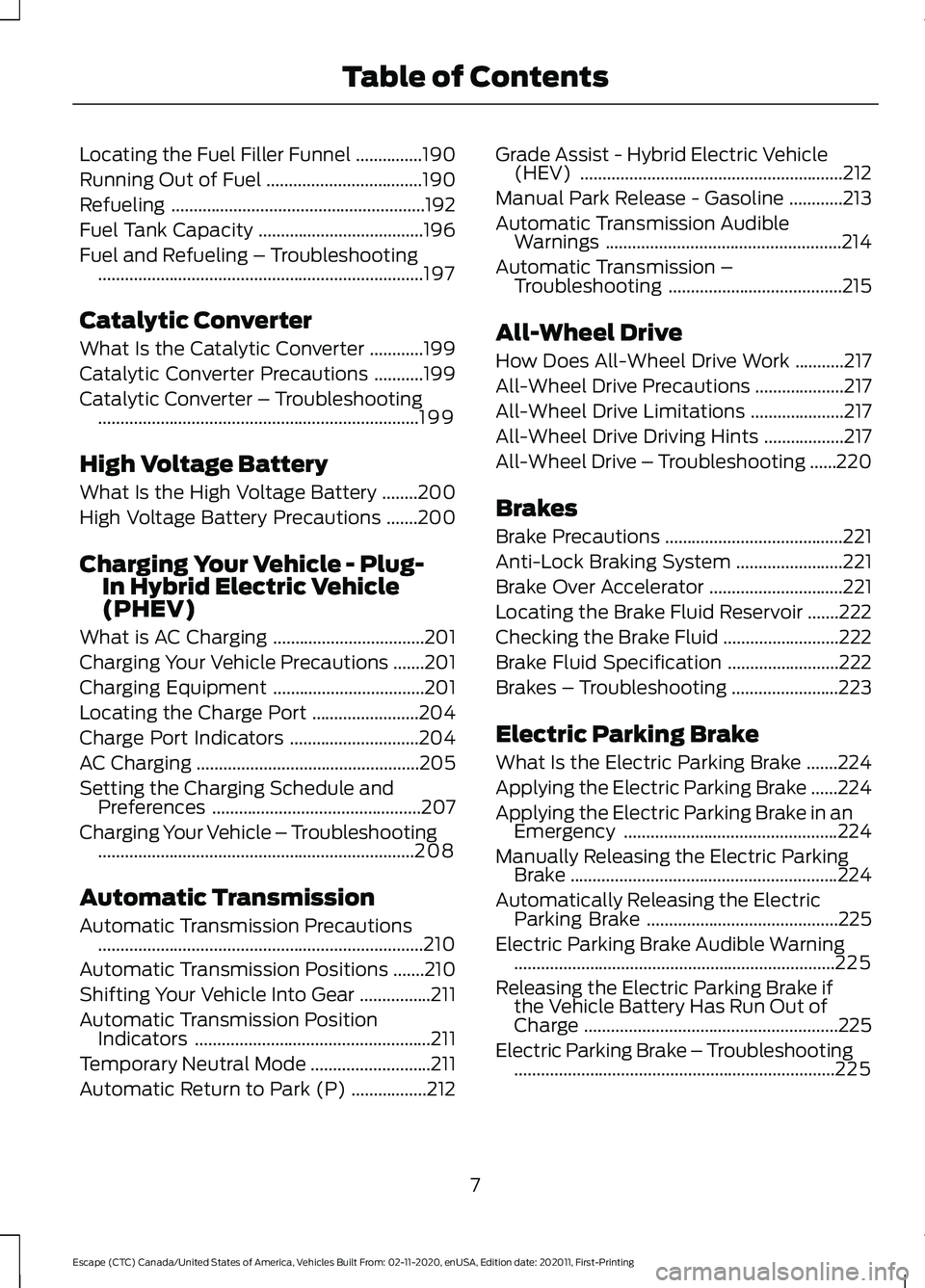
Locating the Fuel Filler Funnel
...............190
Running Out of Fuel ...................................
190
Refueling .........................................................
192
Fuel Tank Capacity .....................................
196
Fuel and Refueling – Troubleshooting ........................................................................\
.
197
Catalytic Converter
What Is the Catalytic Converter ............
199
Catalytic Converter Precautions ...........
199
Catalytic Converter – Troubleshooting ........................................................................\
199
High Voltage Battery
What Is the High Voltage Battery ........
200
High Voltage Battery Precautions .......
200
Charging Your Vehicle - Plug- In Hybrid Electric Vehicle
(PHEV)
What is AC Charging ..................................
201
Charging Your Vehicle Precautions .......
201
Charging Equipment ..................................
201
Locating the Charge Port ........................
204
Charge Port Indicators .............................
204
AC Charging ..................................................
205
Setting the Charging Schedule and Preferences ...............................................
207
Charging Your Vehicle – Troubleshooting .......................................................................
208
Automatic Transmission
Automatic Transmission Precautions ........................................................................\
.
210
Automatic Transmission Positions .......
210
Shifting Your Vehicle Into Gear ................
211
Automatic Transmission Position Indicators .....................................................
211
Temporary Neutral Mode ...........................
211
Automatic Return to Park (P) .................
212Grade Assist - Hybrid Electric Vehicle
(HEV) ...........................................................
212
Manual Park Release - Gasoline ............
213
Automatic Transmission Audible Warnings .....................................................
214
Automatic Transmission – Troubleshooting .......................................
215
All-Wheel Drive
How Does All-Wheel Drive Work ...........
217
All-Wheel Drive Precautions ....................
217
All-Wheel Drive Limitations .....................
217
All-Wheel Drive Driving Hints ..................
217
All-Wheel Drive – Troubleshooting ......
220
Brakes
Brake Precautions ........................................
221
Anti-Lock Braking System ........................
221
Brake Over Accelerator ..............................
221
Locating the Brake Fluid Reservoir .......
222
Checking the Brake Fluid ..........................
222
Brake Fluid Specification .........................
222
Brakes – Troubleshooting ........................
223
Electric Parking Brake
What Is the Electric Parking Brake .......
224
Applying the Electric Parking Brake ......
224
Applying the Electric Parking Brake in an Emergency ................................................
224
Manually Releasing the Electric Parking Brake ............................................................
224
Automatically Releasing the Electric Parking Brake ...........................................
225
Electric Parking Brake Audible Warning ........................................................................\
225
Releasing the Electric Parking Brake if the Vehicle Battery Has Run Out of
Charge .........................................................
225
Electric Parking Brake – Troubleshooting ........................................................................\
225
7
Escape (CTC) Canada/United States of America, Vehicles Built From: 02-11-2020, enUSA, Edition date: 202011, First-Printing Table of Contents
Page 14 of 589

High Voltage Battery Vehicle Precautions
- Hybrid Electric Vehicle (HEV) ..........314
Switching the Hazard Flashers On and Off .................................................................
315
Jump Starting the Vehicle ........................
315
Post-Crash Alert System ..........................
318
Automatic Crash Shutoff .........................
319
Transporting the Vehicle ...........................
319
Towing Your Vehicle
Towing Your Vehicle Precautions ...........
321
Recreationally Towing Your Vehicle - Gasoline, AWD ..........................................
321
Recreationally Towing Your Vehicle - Gasoline, FWD ..........................................
321
Recreationally Towing Your Vehicle - Hybrid Electric Vehicle (HEV)/Plug-In
Hybrid Electric Vehicle (PHEV) ..........
321
Emergency Towing - Hybrid Electric Vehicle (HEV)/Plug-In Hybrid Electric
Vehicle (PHEV) ........................................
322
Emergency Towing - 8-Speed Automatic Transmission – 8F24 .............................
322
Emergency Towing - 8-Speed Automatic Transmission – 8F35 .............................
322
Towing Your Vehicle – Troubleshooting ........................................................................\
323
Fuses
Fuse Precautions ........................................
324
Under Hood Fuse Box ...............................
324
Body Control Module Fuse Box ............
330
Identifying Fuse Types ..............................
332
Fuses – Troubleshooting .........................
332
Maintenance
Maintenance Precautions .......................
333
Opening and Closing the Hood .............
333
Under Hood Overview - 1.5L EcoBoost™ ........................................................................\
335
Under Hood Overview - 2.0L EcoBoost™ ........................................................................\
336 Under Hood Overview - 2.5L, Hybrid
Electric Vehicle (HEV)/Plug-In Hybrid
Electric Vehicle (PHEV) ........................
337
Engine Oil ......................................................
338
Checking the Coolant ...............................
339
Changing the Engine Air Filter - 1.5L EcoBoost™/2.0L EcoBoost™ ...........
343
Changing the Engine Air Filter - 2.5L, Hybrid Electric Vehicle (HEV)/Plug-In
Hybrid Electric Vehicle (PHEV) .........
344
Changing the Fuel Filter - Gasoline, Hybrid Electric Vehicle (HEV) ............
344
Drive Belt Routing Overview - 1.5L EcoBoost™ ...............................................
345
Drive Belt Routing Overview - 2.0L EcoBoost™ ...............................................
345
Changing the 12V Battery ........................
345
Adjusting the Headlamps .......................
348
Exterior Bulbs ...............................................
349
Interior Bulbs .................................................
351
Vehicle Care
Cleaning Products ......................................
352
Cleaning the Exterior .................................
352
Cleaning the Interior ..................................
354
Repairing Minor Paint Damage .............
356
Waxing Your Vehicle ..................................
356
Body Styling Kits
Body Styling Kit Precautions ..................
357
Storing Your Vehicle
Preparing Your Vehicle for Storage ......
358
Removing Your Vehicle From Storage ........................................................................\
359
Wheel and Tire Information
Locating the Tire label .............................
360
Department of Transportation Uniform Tire Quality Grades ...............................
360
Information on the Tire Sidewall ...........
361
Glossary of Tire Terminology .................
366
11
Escape (CTC) Canada/United States of America, Vehicles Built From: 02-11-2020, enUSA, Edition date: 202011, First-Printing Table of Contents
Page 22 of 589
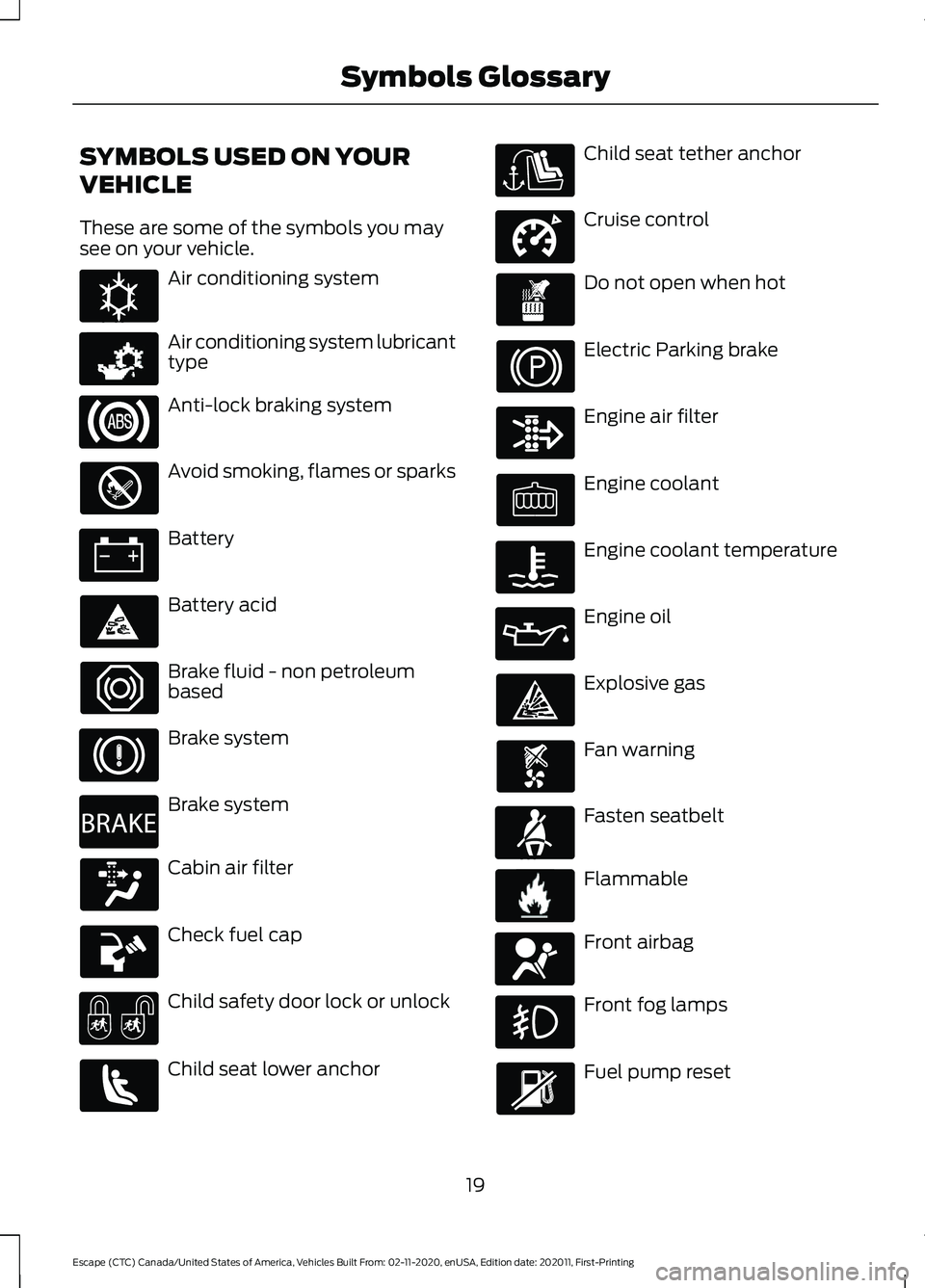
SYMBOLS USED ON YOUR
VEHICLE
These are some of the symbols you may
see on your vehicle.
Air conditioning system
Air conditioning system lubricant
type
Anti-lock braking system
Avoid smoking, flames or sparks
Battery
Battery acid
Brake fluid - non petroleum
based
Brake system
Brake system
Cabin air filter
Check fuel cap
Child safety door lock or unlock
Child seat lower anchor Child seat tether anchor
Cruise control
Do not open when hot
Electric Parking brake
Engine air filter
Engine coolant
Engine coolant temperature
Engine oil
Explosive gas
Fan warning
Fasten seatbelt
Flammable
Front airbag
Front fog lamps
Fuel pump reset
19
Escape (CTC) Canada/United States of America, Vehicles Built From: 02-11-2020, enUSA, Edition date: 202011, First-Printing Symbols GlossaryE162384 E231157 E270480 E332905 E71880 E231160 E67017
Page 25 of 589
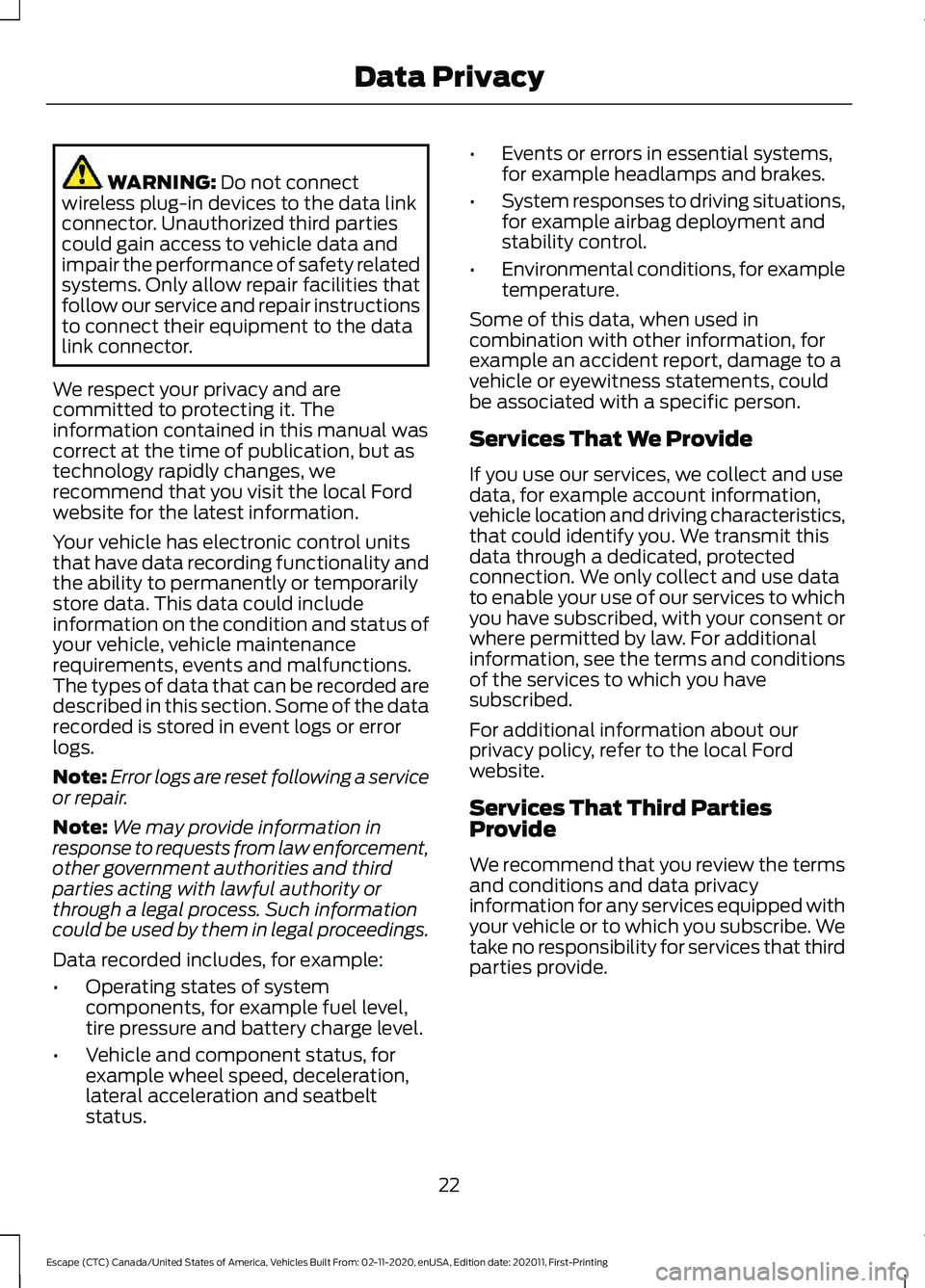
WARNING: Do not connect
wireless plug-in devices to the data link
connector. Unauthorized third parties
could gain access to vehicle data and
impair the performance of safety related
systems. Only allow repair facilities that
follow our service and repair instructions
to connect their equipment to the data
link connector.
We respect your privacy and are
committed to protecting it. The
information contained in this manual was
correct at the time of publication, but as
technology rapidly changes, we
recommend that you visit the local Ford
website for the latest information.
Your vehicle has electronic control units
that have data recording functionality and
the ability to permanently or temporarily
store data. This data could include
information on the condition and status of
your vehicle, vehicle maintenance
requirements, events and malfunctions.
The types of data that can be recorded are
described in this section. Some of the data
recorded is stored in event logs or error
logs.
Note: Error logs are reset following a service
or repair.
Note: We may provide information in
response to requests from law enforcement,
other government authorities and third
parties acting with lawful authority or
through a legal process. Such information
could be used by them in legal proceedings.
Data recorded includes, for example:
• Operating states of system
components, for example fuel level,
tire pressure and battery charge level.
• Vehicle and component status, for
example wheel speed, deceleration,
lateral acceleration and seatbelt
status. •
Events or errors in essential systems,
for example headlamps and brakes.
• System responses to driving situations,
for example airbag deployment and
stability control.
• Environmental conditions, for example
temperature.
Some of this data, when used in
combination with other information, for
example an accident report, damage to a
vehicle or eyewitness statements, could
be associated with a specific person.
Services That We Provide
If you use our services, we collect and use
data, for example account information,
vehicle location and driving characteristics,
that could identify you. We transmit this
data through a dedicated, protected
connection. We only collect and use data
to enable your use of our services to which
you have subscribed, with your consent or
where permitted by law. For additional
information, see the terms and conditions
of the services to which you have
subscribed.
For additional information about our
privacy policy, refer to the local Ford
website.
Services That Third Parties
Provide
We recommend that you review the terms
and conditions and data privacy
information for any services equipped with
your vehicle or to which you subscribe. We
take no responsibility for services that third
parties provide.
22
Escape (CTC) Canada/United States of America, Vehicles Built From: 02-11-2020, enUSA, Edition date: 202011, First-Printing Data Privacy
Page 60 of 589

WHAT IS 911 ASSIST
911 Assist is a SYNC system feature that
can call for help.
For more information, visit
www
. o wner .f or d . c om .
EMERGENCY CALL
REQUIREMENTS WARNING: Do not wait for 911
Assist to make an emergency call if you
can do it yourself. Dial emergency
services immediately to avoid delayed
response time which could increase the
risk of serious injury or death after a
crash. If you do not hear 911 Assist within
five seconds of the crash, the system or
phone may be damaged or
non-functional. WARNING:
Always place your
phone in a secure location in your vehicle
so it does not become a projectile or get
damaged in a crash. Failure to do so may
cause serious injury to someone or
damage the phone which could prevent
911 Assist from working properly. WARNING:
Unless the 911 Assist
setting is set on before a crash, the
system will not dial for help which could
delay response time, potentially
increasing the risk of serious injury or
death after a crash.
• SYNC must be powered and working
properly at the time of the incident and
throughout feature activation and use.
• The 911 Assist feature must be set on
before the incident.
• You must pair and connect a
Bluetooth-enabled and compatible
cell phone to SYNC. •
A connected Bluetooth-enabled phone
must have the ability to make and
maintain an outgoing call at the time
of the incident.
• A connected Bluetooth-enabled phone
must have adequate network coverage,
battery power and signal strength.
• The vehicle must have battery power
and be located in the U.S., Canada or
in a territory in which 911 is the
emergency number.
Note: If any user sets 911 Assist to on or off,
that setting applies for all paired phones. If
911 Assist is off and the phone is connected
to SYNC, an icon displays on the status bar.
Note: Every phone operates differently.
While SYNC 911 Assist works with most
cellular phones, some may have trouble
using this feature.
EMERGENCY CALL
LIMITATIONS
The SYNC 911 Assist feature only operates
in the U.S., Canada or in a territory in which
911 is the emergency number. The following
are limitations of this feature:
• Your cellular phone or 911 Assist
hardware sustains damage in a crash.
• The vehicle's battery or the SYNC
system has no power.
• The phone(s) thrown from your vehicle
are the ones paired and connected to
the system.
57
Escape (CTC) Canada/United States of America, Vehicles Built From: 02-11-2020, enUSA, Edition date: 202011, First-Printing 911 Assist
Page 61 of 589
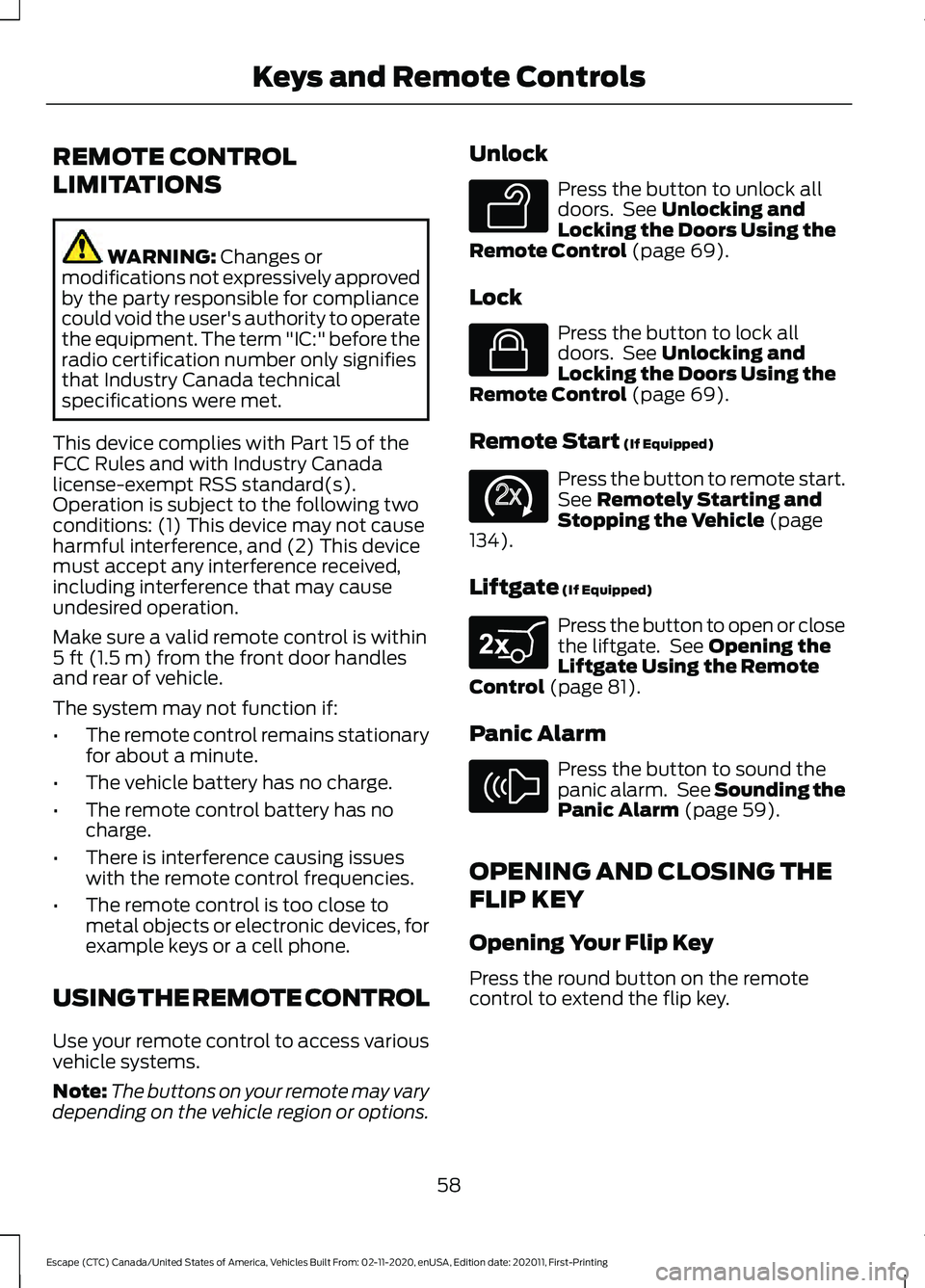
REMOTE CONTROL
LIMITATIONS
WARNING: Changes or
modifications not expressively approved
by the party responsible for compliance
could void the user's authority to operate
the equipment. The term "IC:" before the
radio certification number only signifies
that Industry Canada technical
specifications were met.
This device complies with Part 15 of the
FCC Rules and with Industry Canada
license-exempt RSS standard(s).
Operation is subject to the following two
conditions: (1) This device may not cause
harmful interference, and (2) This device
must accept any interference received,
including interference that may cause
undesired operation.
Make sure a valid remote control is within
5 ft (1.5 m)
from the front door handles
and rear of vehicle.
The system may not function if:
• The remote control remains stationary
for about a minute.
• The vehicle battery has no charge.
• The remote control battery has no
charge.
• There is interference causing issues
with the remote control frequencies.
• The remote control is too close to
metal objects or electronic devices, for
example keys or a cell phone.
USING THE REMOTE CONTROL
Use your remote control to access various
vehicle systems.
Note: The buttons on your remote may vary
depending on the vehicle region or options. Unlock Press the button to unlock all
doors. See
Unlocking and
Locking the Doors Using the
Remote Control
(page 69).
Lock Press the button to lock all
doors. See
Unlocking and
Locking the Doors Using the
Remote Control
(page 69).
Remote Start
(If Equipped) Press the button to remote start.
See
Remotely Starting and
Stopping the Vehicle (page
134).
Liftgate
(If Equipped) Press the button to open or close
the liftgate. See
Opening the
Liftgate Using the Remote
Control
(page 81).
Panic Alarm Press the button to sound the
panic alarm. See Sounding the
Panic Alarm
(page 59).
OPENING AND CLOSING THE
FLIP KEY
Opening Your Flip Key
Press the round button on the remote
control to extend the flip key.
58
Escape (CTC) Canada/United States of America, Vehicles Built From: 02-11-2020, enUSA, Edition date: 202011, First-Printing Keys and Remote ControlsE138629 E138623 E138625 E267940 E138624
Page 63 of 589

CHANGING THE REMOTE
CONTROL BATTERY -
VEHICLES WITH: PUSH
BUTTON START
WARNING: Keep batteries away
from children to prevent ingestion.
Failure to follow this instruction could
result in personal injury or death. If
ingested, immediately seek medical
attention. WARNING:
If the battery
compartment does not securely close,
stop using the remote control and
replace it as soon as possible. In the
meantime, keep the remote control away
from children. Failure to follow this
instruction could result in personal injury
or death.
The remote control uses one coin-type
3-volt lithium battery CR2450 or
equivalent. 1. Push the release button and pull the
key blade out. 2. Twist a thin coin under the tab hidden
behind the key blade head to remove
the battery cover.
60
Escape (CTC) Canada/United States of America, Vehicles Built From: 02-11-2020, enUSA, Edition date: 202011, First-Printing Keys and Remote ControlsE322866 E303824